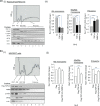Co-regulation of mRNA translation by TDP-43 and Fragile X Syndrome protein FMRP
- PMID: 27518042
- PMCID: PMC5073124
- DOI: 10.1007/s00401-016-1603-8
Co-regulation of mRNA translation by TDP-43 and Fragile X Syndrome protein FMRP
Abstract
For proper mammalian brain development and functioning, the translation of many neuronal mRNAs needs to be repressed without neuronal activity stimulations. We have discovered that the expression of a subclass of neuronal proteins essential for neurodevelopment and neuron plasticity is co-regulated at the translational level by TDP-43 and the Fragile X Syndrome protein FMRP. Using molecular, cellular and imaging approaches, we show that these two RNA-binding proteins (RBP) co-repress the translation initiation of Rac1, Map1b and GluR1 mRNAs, and consequently the hippocampal spinogenesis. The co-repression occurs through binding of TDP-43 to mRNA(s) at specific UG/GU sequences and recruitment of the inhibitory CYFIP1-FMRP complex by its glycine-rich domain. This novel regulatory scenario could be utilized to silence a significant portion of around 160 common target mRNAs of the two RBPs. The study establishes a functional/physical partnership between FMRP and TDP-43 that mechanistically links several neurodevelopmental disorders and neurodegenerative diseases.
Keywords: CYFIP1; FISH; FMRP; Immunofluorescence staining; Live cell imaging; Polysome profile; RNA-IP; TDP-43; Translation initiation.
Figures









Similar articles
-
Molecular switch of the dendrite-to-spine transport of TDP-43/FMRP-bound neuronal mRNAs and its impairment in ASD.Cell Mol Biol Lett. 2025 Jan 15;30(1):6. doi: 10.1186/s11658-024-00684-5. Cell Mol Biol Lett. 2025. PMID: 39815169 Free PMC article.
-
TDP-43 regulates the mammalian spinogenesis through translational repression of Rac1.Acta Neuropathol. 2012 Aug;124(2):231-45. doi: 10.1007/s00401-012-1006-4. Epub 2012 Jul 4. Acta Neuropathol. 2012. PMID: 22760527
-
CYFIP1 coordinates mRNA translation and cytoskeleton remodeling to ensure proper dendritic spine formation.Neuron. 2013 Sep 18;79(6):1169-82. doi: 10.1016/j.neuron.2013.06.039. Neuron. 2013. PMID: 24050404 Free PMC article.
-
Dynamic duo - FMRP and TDP-43: Regulating common targets, causing different diseases.Brain Res. 2018 Aug 15;1693(Pt A):37-42. doi: 10.1016/j.brainres.2018.04.034. Epub 2018 Apr 30. Brain Res. 2018. PMID: 29715444 Free PMC article. Review.
-
Analysis of mRNA translation in cultured hippocampal neurons.Methods Enzymol. 2007;431:143-62. doi: 10.1016/S0076-6879(07)31008-2. Methods Enzymol. 2007. PMID: 17923234 Review.
Cited by
-
TDP-43 transports ribosomal protein mRNA to regulate axonal local translation in neuronal axons.Acta Neuropathol. 2020 Nov;140(5):695-713. doi: 10.1007/s00401-020-02205-y. Epub 2020 Aug 16. Acta Neuropathol. 2020. PMID: 32803350
-
TDP-43 induces EMT and promotes hepatocellular carcinoma metastasis via activating Wnt/β-catenin signaling pathway.Am J Cancer Res. 2020 Oct 1;10(10):3285-3301. eCollection 2020. Am J Cancer Res. 2020. PMID: 33163270 Free PMC article.
-
Ribosome-associated pathological TDP-43 alters the expression of multiple mRNAs in the monkey brain.Zool Res. 2025 Mar 18;46(2):263-276. doi: 10.24272/j.issn.2095-8137.2024.286. Zool Res. 2025. PMID: 39973136 Free PMC article.
-
The role of TDP-43 mislocalization in amyotrophic lateral sclerosis.Mol Neurodegener. 2020 Aug 15;15(1):45. doi: 10.1186/s13024-020-00397-1. Mol Neurodegener. 2020. PMID: 32799899 Free PMC article. Review.
-
RNA Modifications and RNA Metabolism in Neurological Disease Pathogenesis.Int J Mol Sci. 2021 Nov 1;22(21):11870. doi: 10.3390/ijms222111870. Int J Mol Sci. 2021. PMID: 34769301 Free PMC article. Review.
References
MeSH terms
Substances
LinkOut - more resources
Full Text Sources
Other Literature Sources
Research Materials

